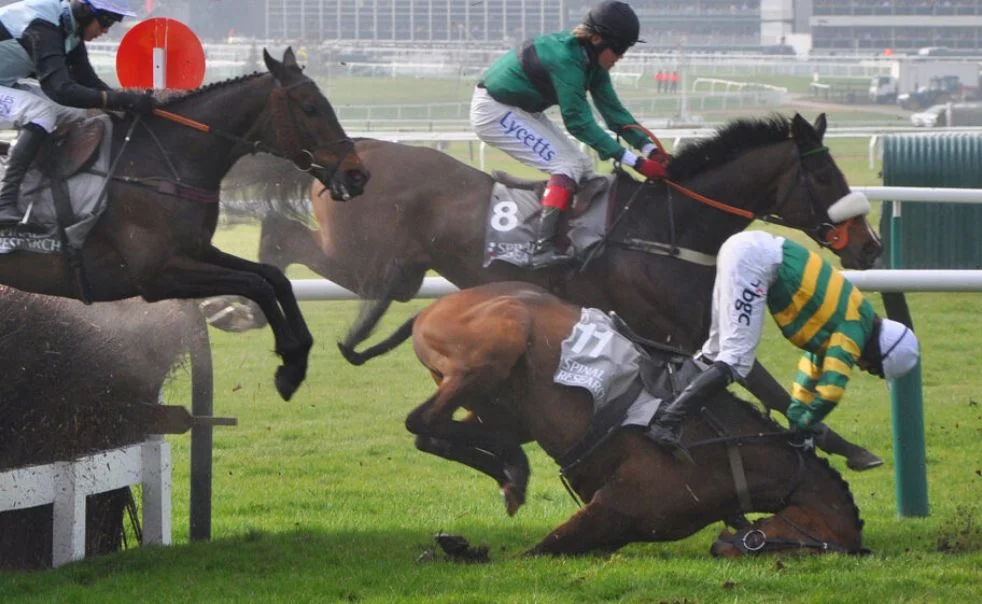Cheltenham Festival Begins Amid Concerns Over Horse Safety

Elle
Mar 20th 2025
Likes
Share:
Starting today, the 2025 Cheltenham Racecourse raises once again horse safety and welfare concerns for racehorses. The continuous involvement of different stakeholders in the debate on the dangers associated with jump racing can be attributed to the high fatality rate of these equines-in major cases, since the year 2000, around 76 horses have died in four days of events.
The Cheltenham Racecourse is considered one of the most dangerous places in horse racing. Acceleration, extreme jumping, and the drive to win make for a very dangerous situation for horses. Many end up being severely injured and some succumb to the very pressures that led them to that racing day.
Jump racing, or National Hunt racing, entails having horses run at high speeds, clearing tall obstacles in the process. The fragility of horses often consists of being hurt from a tumble at high speeds while jumping fences. In spite of this, the racing fraternity continues to drive these animals far beyond their physical capabilities, not paying any attention to any warning signs along the way that may have prevented injury.
More than 3000 horses have died in National Hunt racing since 2001. Racing supporters maintain that horse safety has become better with time. The fatalities, however, tell a different story. The Cheltenham Racecourse and the Aintree Grand National remain among the most dangerous events for horses, and there are increasing calls for their ban.
Animal Aid and other animal protection organizations assert that there is no justification of the sport against such great risks. Horses have no choice in these events, yet they face life-threatening conditions that put their well-being at risk for entertainment and gambling profits.
Animal Aid has published a report, Victims of Abuse in British Horse Safety Racing, outlining the extent of harm caused by the industry.
Add to the growing worry concerned with horses before, during, and after their racing careers. These intense training regimes, along with early retirements, can leave many horses facing uncertain futures when they are no longer deemed profitable. The use of the whip for training, upon which certain regulations are imposed, appears to plus to injury that these animals suffer, which reinforces the necessity for stricter enforcement of animal welfare policies.
Horse racing closely proves fatal; many horses are victims of catastrophic injuries while racing on the tracks. Though there are some reforms, the yearly horse racing fatalities signify a serious ethical issue beyond argument. Supporters of this sport justify their stance with a belief that it is ancient tradition; however, traditions should not be paid with the life of an animal. If nothing astounding occurs, horse racing fatalities will continue to be at the heart of the argument regarding whether or not the industry could ever genuinely embrace animal welfare.
Horse racing fatalities are witness to public attention and awareness on one side, whereas on the other side, pressure is building on the industry that prioritizes safety for the horse by enhancing horse safety measures, tightening regulations, and enforcing accountability.
Animal Aid and other advocacy groups are increasing pressure to end jump racing, calling for stronger protections for horses. Public awareness continues to rise, with more people questioning whether this industry should continue in its current form.
Concerns over horse safety welfare will indeed stand out in the spotlight as the Cheltenham Racecourse season of 2025 opens. The release of new data strengthens the evidence for major changes and has campaigners hoping that growing public awareness will cause action to take place.
Increasing concern over horse welfare in jumping racing is about the injuries and deaths caused – the injured horse’s plight tends to make headlines. They argue that falls, fractures, and exhaustion are now unacceptable threats to those horses, raised by animal welfare groups and critics of racing. Reformers on the other hand will advocate for stricter regulations, improved track conditions, and better medical treatment; but to critics, their argument ends with the elimination of jump racing.
Loud debate transcends the sport, extending to other forms of equestrian competition and to the overall ethics of treating any animal within that competition. While awareness grows, it puts further public pressure on industry leaders to remedy horse-related concerns lest they lose public support. With racing organizations responding in different ways, the future of jump racing may ultimately depend on how well the sport adapts to growing demands for horse safety measures.
No horse should suffer or die for the sake of entertainment. The events at Cheltenham Racecourse and beyond highlight the need for serious reform before more lives are lost.
